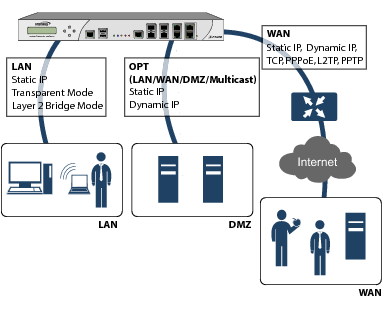|
•
|
Static IP—Uses a static IP address and acts as a gateway for devices on the LAN.
|
|
•
|
Transparent Mode—Allows you to assign a single IP address to two physical interfaces, where each interface accesses an exclusive range of IP addresses in the shared subnet. Behaves as a proxy at Layer 3, intercepting ARPs and changing source MAC addresses of packets traversing the interface pair.
|
|
•
|
Layer 2 Bridged Mode—Similar to Transparent Mode, but dynamically learns IP addresses on both interfaces so that you do not need to subdivide the subnet that is being bridged. Provides deep-packet inspection and application of policies before forwarding packets. Places the bridged interfaces into promiscuous mode and passes traffic between them with source and destination MAC addresses intact.
|
|
•
|
Wired Mode—Adding to the broad collection of traditional modes of SonicOS interface operation, including all LAN modes (Static, NAT, Transparent Mode, L2 Bridge Mode, Portshield Switch Mode), and all WAN modes (Static, DHCP, PPPoE, PPTP, and L2TP), SonicOS 5.8 introduces Wire-Mode, which provides four new methods non‑disruptive, incremental insertion into networks.
|
|
•
|
Tap Mode—Provides the same visibility as Inspect Mode, but differs from the latter in that it ingests a mirrored packet stream by a single switch port on the SonicWALL security appliance, eliminating the need for physically intermediated insertion. Tap Mode is designed for use in environments employing network taps, smart taps, port mirrors, or SPAN ports to deliver packets to external devices for inspection or collection. Like all other forms of Wire Mode, Tap Mode can operate on multiple concurrent port instances, supporting discrete streams from multiple taps.
|
Figure 1 shows the basic interfaces for a SonicWALL appliance. The WAN interface can use a static or dynamic IP address and can connect to the Internet through Transmission Control Protocol (TCP), Point-to-Point Protocol over Ethernet (PPPoE), Level 2 Tunneling Protocol (L2TP), or Point-to-Point Tunneling Protocol (PPTP).
Figure 1. Interfaces
